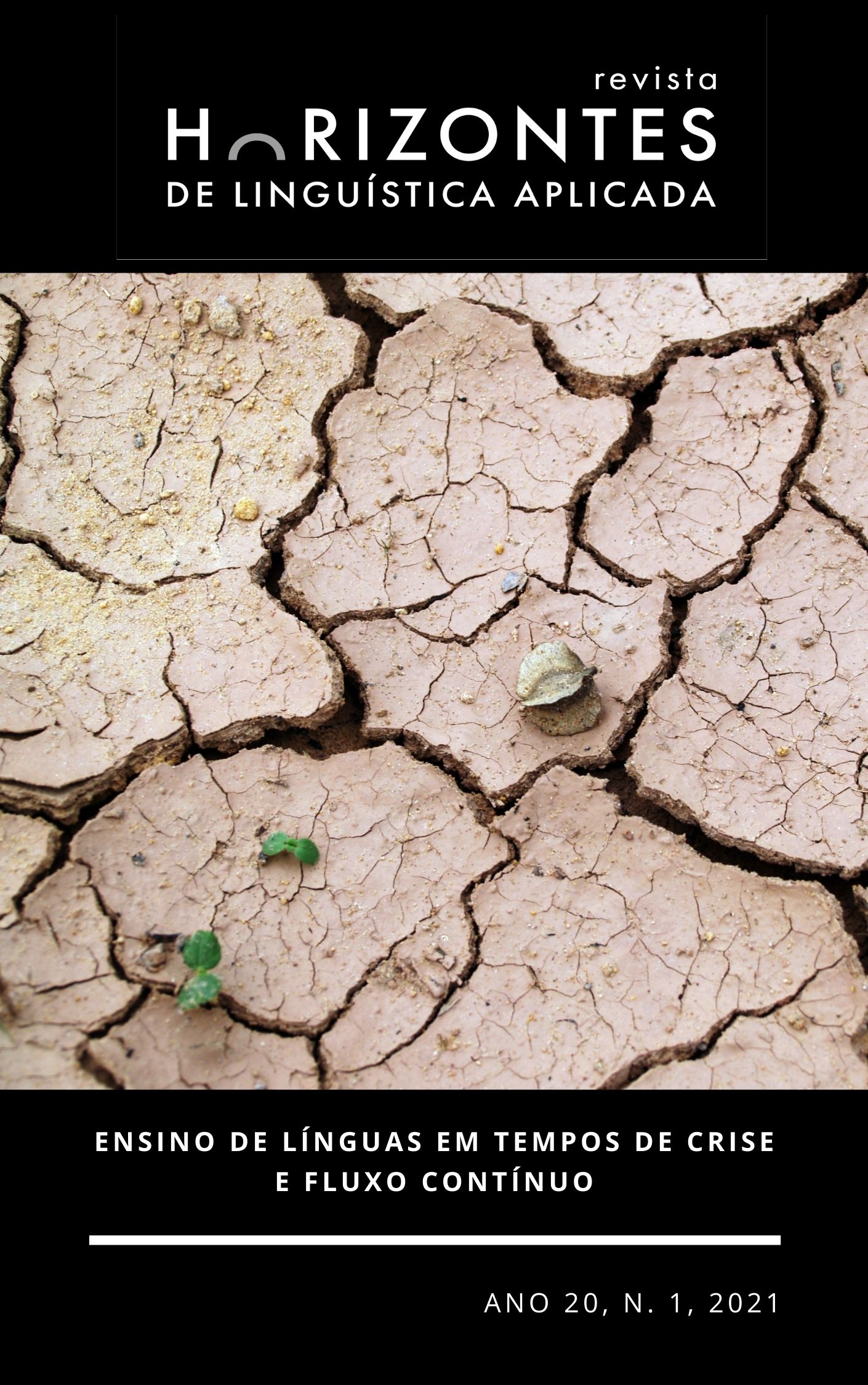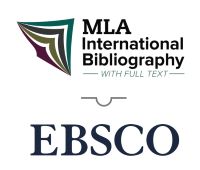O diário como instrumento metodológico no ensino e na pesquisa em inglês
DOI:
https://doi.org/10.26512/rhla.v20i1.34303Palavras-chave:
multiletramentos, diário, interdisciplinariedade, autonomia, metodologia em Ciências HumanasResumo
A pesquisa em Ciências Humanas sempre enfrentou questionamentos sobre confiabilidade devido à complexidade de seu objeto de estudo, tornando discussões sobre seus instrumentos metodológicos relevantes. Este estudo, realizado em uma instituição de ensino pública, focaliza o uso de diários pelos alunos em uma investigação sobre multiletramentos e autonomia no ensino de inglês, por meio do trabalho em conjunto das disciplinas de automação e língua inglesa. Busca-se responder duas perguntas: há evidências da eficácia metodológica do diário? Quais conclusões podem ser depreendidas das opiniões dos participantes elaboradores dos diários? Um questionário composto por perguntas abertas e fechadas também foi aplicado aos alunos. Os resultados apontam para a eficácia do diário, que possibilita o acesso a dados que não seriam possíveis de serem identificados externamente e auxilia os alunos em reflexões, compreensão e organização do processo de aprendizado.
Downloads
Referências
AYDIN, S. Factors causing demotivation in EFL teaching process: a case study. The Qualitative Report, v.17, p. 1-13, 2012.
ALLWRIGHT, D.; BAILEY, K. M. Focus on the language classroom: an introduction to classroom research for language teachers. Cambridge: Cambridge University Press, 1991.
ARANHA, M. L. A.; MARTINS, M. H. P. Filosofando: introdução à filosofia. 2. ed. São Paulo: Moderna, 2001.
BAILEY, K. M. The use of diary studies in teacher education programs. In: RICHARDS, J. C.; NUNAN, D. (Eds.). Second language teacher education. Cambridge: CUP, 1990. p. 215-226.
BAILEY, K. M. Competitiveness and anxiety in adult second language learning: looking at an through the diary studies. In: SELIGER, H. W.; LONG, M. H. (Eds.). Classroom oriented research in second language acquisition. Rowley, Mass: Newbury House, 1983. p. 67-103.
BAILEY, K. M. Diary studies of classroom language learning: the doubting game and the believing game. In: SADTONO, E. (Ed.). Language acquisition and the second/foreign language classroom. Singapore: SEAMEO Regional Language Centre (Anthology Series 28), 1991. p. 60-102.
BANERJEE, J. V. Qualitative analysis methods (Section D): reference supplement to the preliminary pilot version of the manual for relating language examinations to the Common European framework of reference for languages: learning, teaching, assessment. Strasbourg: Language Policy Division, Council of Europe, 2004.
BENSON, P. The philosophy and politics of learner autonomy. In P. Benson, P. Voller (Eds.). Autonomy and independence in language learning. London: Longman, 1997. p. 18-34.
BENSON, P. Teaching and researching autonomy in language learning. London: Longman, 2001.
BROCK, M. N. YU, B., WONG, M. ”Journaling” together: collaborative diary-keeping and teacher development. In: J. Flowerdew; M. Brock; S. Hsia (Eds.). Perspectives on second language teacher education. Hong Kong: City Polytechnic of Hong Kong, 1992. p-295-307.
BROWN, J. D. Understanding research in second language learning: a teacher’s guide to statistics and research design. New York: Cambridge University Press, 1988.
BRASIL. Ministério da Educação. Base Nacional Comum Curricular: Ensino Médio. Brasília, 2017.
CARRELL, P.; EISTERHOLD, J. Schema theory and ESL reading. TESOL Quarterly, 17, p. 553-573, 1983.
CARSON, J. G.; LONGHINI, A. Focusing on learning styles and strategies: a diary study in an immersion setting. Language Learning, v. 52, n. 2, p. 401-438, 2002.
CANDLIN, C., General editor’s preface. In: P. Benson; P. Voller (Eds.). Autonomy and independence in language learning. Harlow: Longman, 1997.
CHAO, T. A diary study of university EFL learners' intercultural learning through foreign films. Language, Culture and Curriculum, v. 26, n. 3, p. 247-265, 2013.
CHAUDRON, C. The interaction of quantitative and qualitative approaches to research: a view of the second language classroom. TESOL Quarterly, v. 20, p. 709-717, 1988.
CHAUÍ, M. Convite à filosofia. 12. ed. São Paulo: Ática, 2002.
COPE, B.; KALANTZIS, M. “Multiliteracies”: new literacies, new learning. Pedagogies: An International Journal, v. 4, p. 164-195, 2009.
DENZIN, N.; LINCOLN, Y. O planejamento da pesquisa qualitativa: teorias e práticas. Tradução de Sandra Regina. Netz. Porto Alegre: Armed, 2006.
DUKE, J. Joining the dots: piloting the work diary as a data collection tool. Issues in Educational Research, v. 22, n. 2, p. 111-126, 2012.
ELLIOT, M.; WILSON, J. Content validity. In: GERANPAYEH, A.; TAYLOR, L. (Ed.). Examining listening: research and practice in assessing second language listening. Cambridge: Cambridge University Press, 2013. p. 152-24.
FAZENDA, I. C. A. Interdisciplinaridade: um projeto em parceria. Coleção Educar. v. 13. São Paulo: Loyola, 1991.
FAZENDA, I. C. A. Interdisciplinaridade: história, teoria e pesquisa. Campinas: Papirus, 1994.
FLICK, U. An introduction to qualitative research: theory, method and applications. 5 ed. London: Sage, 2014.
GIL, A. C. Métodos e técnicas de pesquisa social. 5. ed. São Paulo: Atlas, 1999.
GROTJAHN, R. On the methodological basis of introspective methods. In: FAERCH, C.; KASPER, F. (Ed.). Introspection in second language research. Clevedon Avon, England: Multilingual Matters, 1987.
HANSEN-THOMAS, H. A case study of reflective journals in a university level writing course in Hungary. English Teaching Forum, v. 41, n. 1, p-22-28, 2003.
HOLEC, H. Autonomy and foreign language learning. Oxford/New York: Pergamon Press, 1981.
HOLMES, V. L.; MOULTON, M. R. A contrarian view of dialogue journals: the case of a reluctant participant. Journal of Second Language Writing, v. 4, n. 3, p. 223-251, 1995.
JOHNSON, K.; JOHNSON, H. (Ed.). Encyclopaedic dictionary of applied linguistics: a handbook for language teaching. Oxford: Blackwell Publishers, 1998.
KOBAYASHI, E., ZAMPINI, E. Multiletramentos e autonomia: um estudo de caso no ensino de língua inglesa. Revista do GEL, v. 17, n. 1, p. 138-159, 2020.
LEE, E. The significance of building and activating background knowledge in the teaching of Shakespeare in the ESL classroom. Polyglossia, v. 15, 2008. Disponível em: https://www.apu.ac.jp/rcaps/uploads/fckeditor/publications/polyglossia/Polyglossia_V15_Lee.pdf. Acesso em: 10 set. 2020.
LEFFA, V. J. Quando menos é mais: a autonomia na aprendizagem de línguas. In: NICOLAIDES, C.; MOZZILLO, I.; PACHALSKI, L.; MACHADO, M.; FERNANDES, V. (Orgs.). O desenvolvimento da autonomia no ambiente de aprendizagem de línguas estrangeiras. Pelotas: UFPEL, 2003. p. 33-49.
MACKEY, A. Input, interaction and second language development: an empirical study of question formation in ESL. Studies in Second Language Acquisition, v. 21, n. 4, p. 557-587, 1999. Disponível em: http://dx.doi.org/10.1017/S0272263199004027
MAHMOUDI, S. Investigating the effect of cultural schemata activation on EFL learners’ listening comprehension. English Language, Literature, Culture, v. 2, p. 99-104, 2017.
MATSUMOTO, K. Diary studies of second language acquisition: a critical overview. JALT Journal, v. 9, n. 1, p. 17-34, 1987.
MOCHIZUKI, N.; ORTEGA, L. Balancing communication and grammar in beginning-level foreign language classrooms: a study of guided planning and relativization. Language Teaching Research, v. 12, n. 1, p. 11-37, 2008. Disponível em: http://dx.doi.org/10.1177/1362168807084492
NUNAN, D. Research methods in language learning. Cambridge: Cambridge University Press, 2005.
OLIVEIRA, P. S. Caminho de construção da pesquisa em ciências humanas, 1998. Disponível em: https://repositorio.usp.br/item/001003899. Acesso em: 17 set. 2020.
OPPENHEIM, A. N. Questionnaire design, interviewing and attitude measurement. London: Cassell, 1992.
OXFORD, R. L. Language learning strategies: what every teacher should know. New York: Newbury House, 1990.
PAIVA, V. L. M. O. Autonomia e complexidade. Linguagem & Ensino, v. 9, n. 1, p. 77-127, 2006.
PALMER, C.; PALMER, G. Diary Keeping and Reflecting on Practice. In: PECK, A.; WESTGATE, D. (Eds.). Language Teaching in the Mirror. London: Centre for Information on Language Teaching and Research (CILT), 1994. p. 30-36.
PARKINSON, B.; HOWELL-RICHARDSON, C. Learner diaries. In: BRUMFIT, C. J.; MITCHELL, R. (Eds.). Research in the language classroom, ELT Documents 133, London: Modern English Publications/British Council, p. 128-400, 1990.
PORTER, P. A.; GOLDSTEIN, L. M.; LEATHERMAN, J.; CONRAD, S. An ongoing dialogue: learning logs for teachers. In: RICHARDS, J. C.; NUNAN, D. (Eds.). Second language teacher education. Cambridge, UK: Cambridge University Press, 1990. p. 227-240.
RICHARDS, J. C.; LOCKART, C. Reflective teaching in second language classroom. Cambridge: Cambridge University Press, 1994.
ROJO, R. Entre plataformas, ODAS e protótipos: novos multiletramentos em tempos de web. The Especialist: Descrição, ensino e aprendizagem, v. 38, n. 1, p. 1-19, 2017.
SAKUI, K. Wearing two pairs of shoes: language teaching in Japan. ELT Journal, v. 58, n. 2, p. 155-163, 2004. Disponível em: http://dx.doi.org/10.1093/elt/58.2.155
SCHMIDT, R. W.; FROTA, S. N. Developing basic conversational ability in a second language: a case study of an adult learner of portuguese. In: DAY, R. R. (Ed.). Talking to learn: conversation in second language acquisition. Rowley: Newbury House, 1986. p. 237-326.
SIEGEL, J. Advice in listening instruction: degrees of transferability. International Journal of Innovation in English Language Teaching and Research, v. 3, n. 2, p. 1-18, 2013.
SKEHAN, P. Task-based instruction. In: GRABE, W. (Ed.). Annual Review of Applied Linguistics. New York: Cambridge University Press, 1998. p. 268-286.
SOMMERMAN, A. Inter ou transdisciplinaridade: da fragmentação disciplinar ao novo diálogo entre saberes. São Paulo: Paulus, 2006.
SYMON, G. Qualitative Research Diaries. In: SYMON G.; CASSELL, C. (Eds.). Qualitative methods and analysis in organizational research: a practical guide. London: Sage Publications Inc., 1998. p. 94-117.
TUDOR, I. Learner-centredness as language education. Cambridge: Cambridge University Press, 1997.
VAN LIER, L. Ethnographty: bandaid, bandwagon or contraband. In: BRUMFIT, C.; MITCHELL, R. (Eds.). Research in the language classroom. London: Modern English Publications, 1990.
VAN LIER, L. The classroom and the language learner. London: Longman, 1989.
YASTIBAS, G.; YASTIBAS, A. The effect of peer feedback on writing anxiety in Turkish EFL (English as a Foreign Language) students. Procedia: Social and Behavioral Sciences, v. 199, p. 530-538, 2015.
WARSCHAUER, M. A developmental perspective on technology in language education. TESOL Quarterly, v. 36, n. 3, p. 453-475, 2002.
WENDEN, A. Learner strategies for learner autonomy. Englewood Cliffs: Prentice Hall, 1991.
Downloads
Publicado
Como Citar
Edição
Seção
Licença
Copyright (c) 2021 Revista Horizontes de Linguistica Aplicada

Este trabalho está licenciado sob uma licença Creative Commons Attribution-NonCommercial-NoDerivatives 4.0 International License.

Artigos publicados pela Revista Horizontes de Linguística Aplicada são licenciados sob uma Licença Creative Commons Atribuição-NãoComercial-SemDerivações 4.0 Internacional.
Ao publicar na Horizontes de Linguística Aplicada, os autores concordam com a transferência dos direitos autorais patrimoniais para a revista. Os autores mantêm seus direitos morais, incluindo o reconhecimento da autoria.
Autores e leitores têm o direito de:
Compartilhar — copiar e redistribuir o material em qualquer suporte ou formato
De acordo com os termos seguintes:
- Atribuição — Você deve dar o crédito apropriado , prover um link para a licença e indicar se mudanças foram feitas . Você deve fazê-lo em qualquer circunstância razoável, mas de nenhuma maneira que sugira que o licenciante apoia você ou o seu uso.
- NãoComercial — Você não pode usar o material para fins comerciais .
- SemDerivações — Se você remixar, transformar ou criar a partir do material, você não pode distribuir o material modificado.
- Sem restrições adicionais — Você não pode aplicar termos jurídicos ou medidas de caráter tecnológico que restrinjam legalmente outros de fazerem algo que a licença permita.








